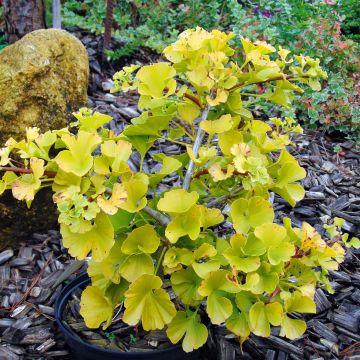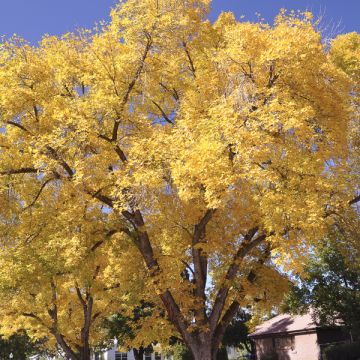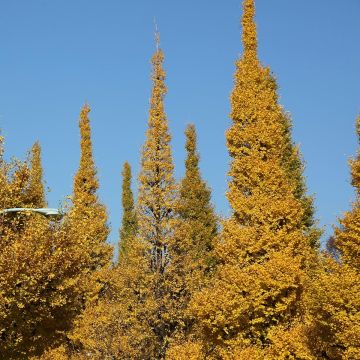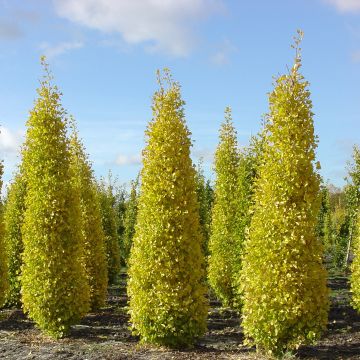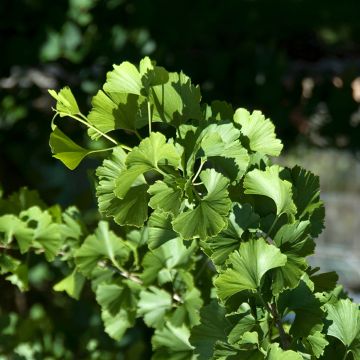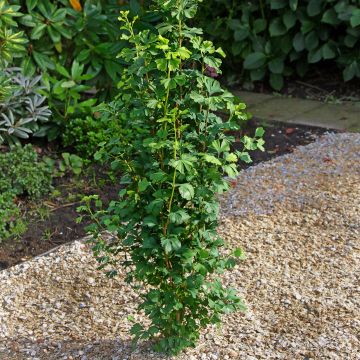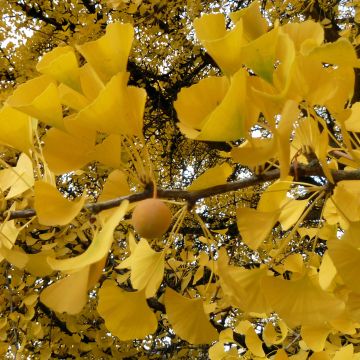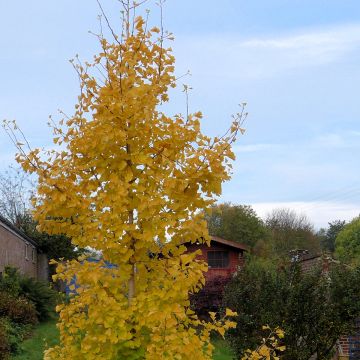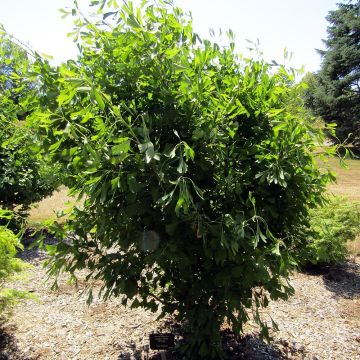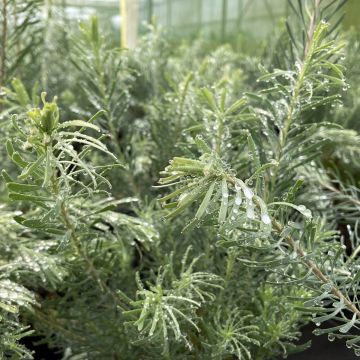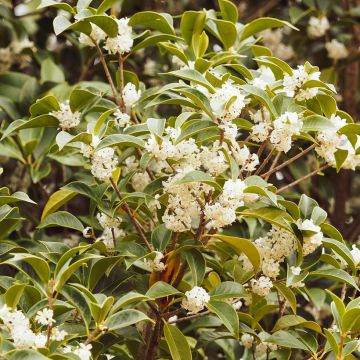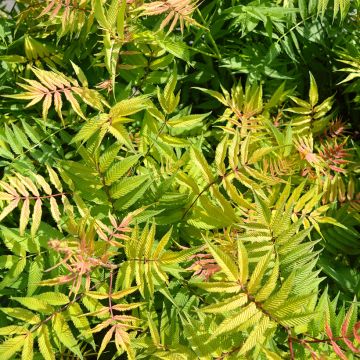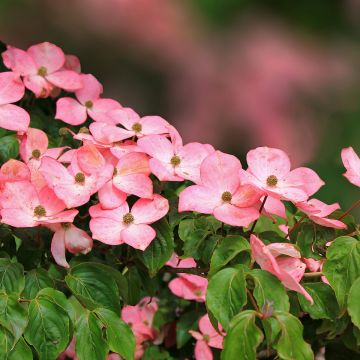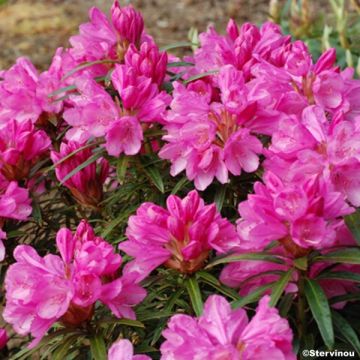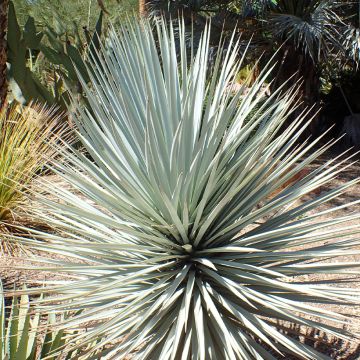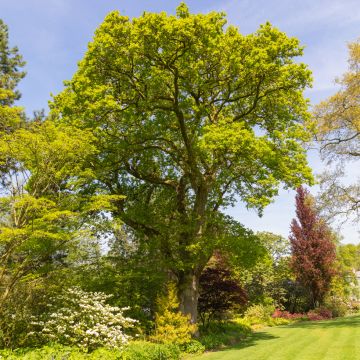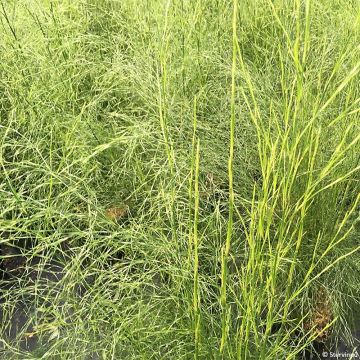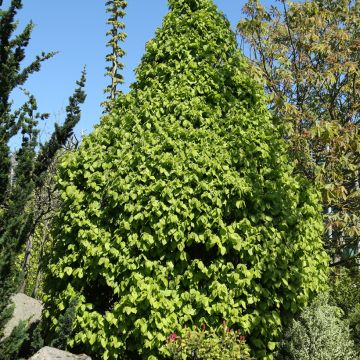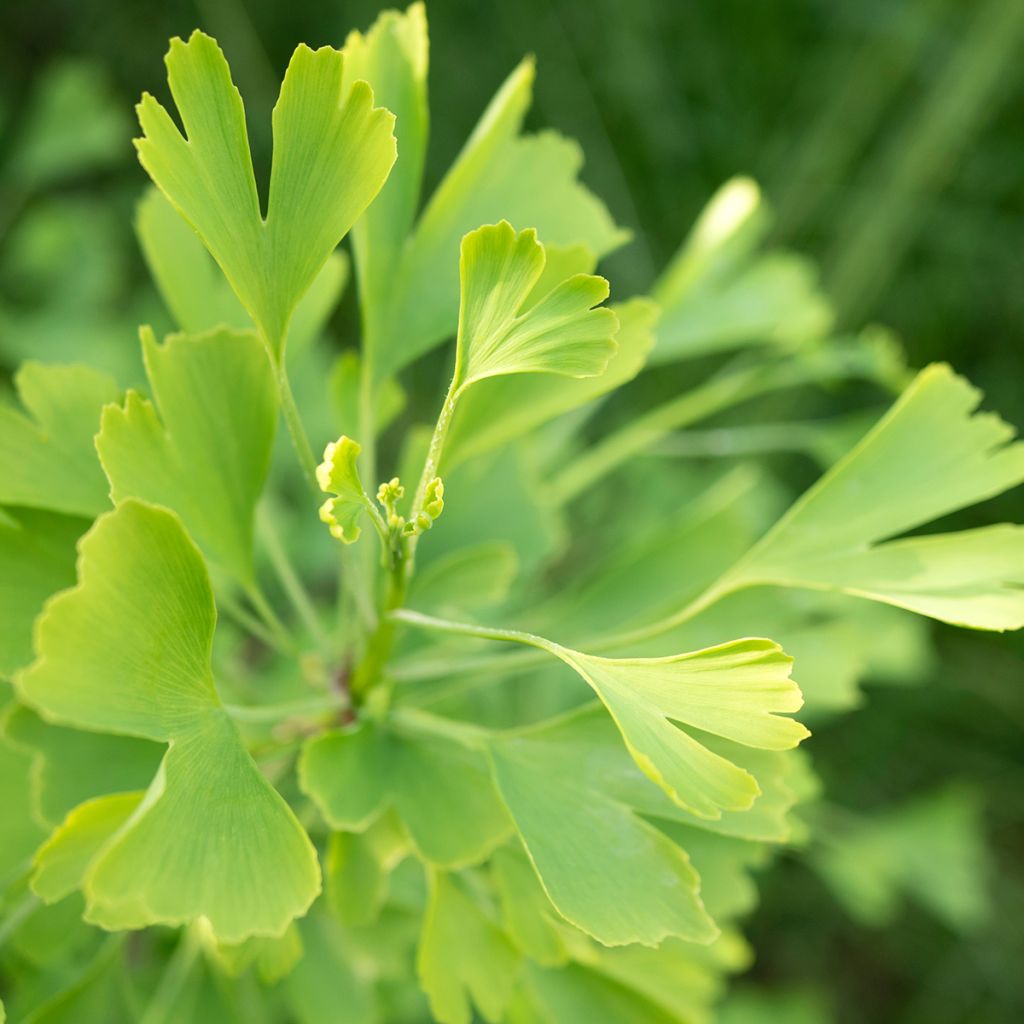

Ginkgo biloba Baldii - Maidenhair tree
Ginkgo biloba Baldii - Maidenhair tree
Ginkgo biloba Baldi
Maidenhair Tree
This item cannot be shipped to the selected country
Delivery charge from €5.90
More information
Schedule delivery date,
and select date in basket
This plant carries a 24 months recovery warranty
More information
We guarantee the quality of our plants for a full growing cycle, and will replace at our expense any plant that fails to recover under normal climatic and planting conditions.
From €5.90 for pickup delivery and €6.90 for home delivery
Express home delivery from €8.90.
Does this plant fit my garden?
Set up your Plantfit profile →
Description
Ginkgo biloba 'Baldi' is a variety of Dwarf Maidenhair Tree. Its silhouette is more like a bush than a tree, with an open and spreading aspect, and a spread similar to its height. Its foliage is faithful to the original species with two lobes forming a small fan, easy to recognize. The beautiful bright green foliage turns a superb golden yellow in autumn, which gives it its name of Dwarf Maidenhair Tree. Plant it in the sun, in any good garden soil that is not too dry, or even in a pot to enhance a terrace or balcony.
Ginkgo biloba is the only living member of the Ginkgoaceae family, with the other representatives known only as fossils. It is a plant that does not produce flowers and has naked seeds. It is classified as a Gymnosperm, alongside the large group of conifers.
This large tree is dioecious, with some trees being female and others male. The Ginkgo can live for several thousand years and forms magnificent specimens that can exceed 30 m high. Originally from China, it has now (and probably for a long time) disappeared from its natural habitat and now only survives because it was admired by humans for many generations and has been propagated and planted in our most beautiful parks.
Ginkgo biloba 'Baldii' is a relatively recent horticultural variety, originating from Germany. The Balke nurseries (in Leipzig, Saxony) selected this compact form from a "witches' broom". This is a proliferation of branches caused by a fungus, bacterium, or other organism, which forms a tuft on the branches of certain trees, such as Pines for example. The Dittersdorf company was responsible for bringing it to the market in 2009, under the name Baldii, "Bal" for Balke and "di" for Dittersdorf.
It is a compact variety with a distinctly shrubby habit, very different from the original species. It is slow-growing, about 10 cm per year, it will take about ten years to reach 1 m in all directions, and its size at maturity will not exceed 2 m. This well-branched plant produces numerous shoots that rise at an angle of approximately 45° to the vertical, giving it an open, relatively spreading silhouette, almost as wide as it is tall. The leaves are slightly smaller than those of the botanical species, and have the same characteristic shape. The V-shaped base, carried by a fairly long petiole, widens into a fan, deeply notched into 2 lobes. These leaves are unique in the plant kingdom with their easily recognizable shape and are surprisingly veined in the direction of their length. Botanically close to conifers, they could be fused needles. The leaves are initially slightly bluish-green and turn to a deeper and rather matte green during the growing season. In autumn, the foliage offers a magnificent spectacle by taking on a golden yellow colour, one of the most beautiful there is. After the leaves have fallen, the ground remains strewn with gold for some time.
Being a male cultivar, 'Baldii' produces inflorescences in the form of pendant cylindrical catkins, about 4 or 5 cm long, with a yellowish-green colour and no real ornamental interest. It will therefore not produce fruits.
It grows in most soils, not too dry or too wet, in full sun or under light shade. It is very resistant to frost and atmospheric pollution, it is also not susceptible to diseases or insects, against which it can deploy effective defences (toxic molecules and other strategies).
Ginkgo 'Baldii' can be planted in a container near an entrance, on the terrace, or as a standalone specimen on a lawn, where it will become a focal point for much of the year. Its design integrates particularly well into Japanese, exotic, or contemporary settings. In a small garden, it can be planted in a bed of other small plants to create a pleasing visual effect. Pair it with compact shrubs with decorative foliage, such as Berberis thunbergii Admiration, whose leaves change colour throughout the seasons. You can also create a beautiful Japanese scene by combining it with Acer palmatum Bi Hoo, an ornamental Japanese Maple which is stunning in all seasons, thanks to its beautiful changing palmate foliage and its branches and stems adorned with beautiful yellow bark.
Ginkgo is the oldest species of tree found on Earth: dating back 300 million years, it has survived all the cataclysms that the Earth has experienced (a famous specimen also survived in Hiroshima, recovering from the effects of the bomb dropped 1 km away...). This tree with a thousand leaves has been living for thousands of years in the Tianmushan Mountains in southeastern China. It was introduced to Europe in the 18th century. With exceptional longevity, the Ginkgo is also a medicinal plant, with its foliage used to reduce symptoms of Alzheimer's disease.
Report an error about the product description
Plant habit
Foliage
Botanical data
Ginkgo
biloba
Baldi
Ginkgoaceae
Maidenhair Tree
Cultivar or hybrid
Other Ginkgo
Planting and care
Ginkgo biloba 'Baldii' is a small but very hardy tree, withstanding temperatures as low as -30°C when fully grown. In its early years, it is slightly more sensitive to cold. It dislikes excessive heat and starts to suffer beyond 30°C, especially if the soil is dry. It thrives in full sun in any good, fertile, deep, and well-drained soil. It is also important to ensure it does not lack water during the summer period. It tolerates slightly alkaline soil as long as it remains moist. In dry soil, this tree will grow even more slowly. However, it will also suffer in soil that is too wet and heavy, constantly saturated with water. It is a very resilient bush that withstands urban pollution well. When planting, dig a sufficiently deep hole and enrich it with planting compost. Soak the root ball in a bucket for 15 minutes before planting it, backfill around it, and water it abundantly. This Ginkgo does not require pruning, although you can intervene if necessary during the plant's dormant period, in February-March, to remove tangled stems and maintain a balanced shape.
Planting period
Intended location
Care
This item has not been reviewed yet - be the first to leave a review about it.
Striking foliage shrubs
Haven't found what you were looking for?
Hardiness is the lowest winter temperature a plant can endure without suffering serious damage or even dying. However, hardiness is affected by location (a sheltered area, such as a patio), protection (winter cover) and soil type (hardiness is improved by well-drained soil).

Photo Sharing Terms & Conditions
In order to encourage gardeners to interact and share their experiences, Promesse de fleurs offers various media enabling content to be uploaded onto its Site - in particular via the ‘Photo sharing’ module.
The User agrees to refrain from:
- Posting any content that is illegal, prejudicial, insulting, racist, inciteful to hatred, revisionist, contrary to public decency, that infringes on privacy or on the privacy rights of third parties, in particular the publicity rights of persons and goods, intellectual property rights, or the right to privacy.
- Submitting content on behalf of a third party;
- Impersonate the identity of a third party and/or publish any personal information about a third party;
In general, the User undertakes to refrain from any unethical behaviour.
All Content (in particular text, comments, files, images, photos, videos, creative works, etc.), which may be subject to property or intellectual property rights, image or other private rights, shall remain the property of the User, subject to the limited rights granted by the terms of the licence granted by Promesse de fleurs as stated below. Users are at liberty to publish or not to publish such Content on the Site, notably via the ‘Photo Sharing’ facility, and accept that this Content shall be made public and freely accessible, notably on the Internet.
Users further acknowledge, undertake to have ,and guarantee that they hold all necessary rights and permissions to publish such material on the Site, in particular with regard to the legislation in force pertaining to any privacy, property, intellectual property, image, or contractual rights, or rights of any other nature. By publishing such Content on the Site, Users acknowledge accepting full liability as publishers of the Content within the meaning of the law, and grant Promesse de fleurs, free of charge, an inclusive, worldwide licence for the said Content for the entire duration of its publication, including all reproduction, representation, up/downloading, displaying, performing, transmission, and storage rights.
Users also grant permission for their name to be linked to the Content and accept that this link may not always be made available.
By engaging in posting material, Users consent to their Content becoming automatically accessible on the Internet, in particular on other sites and/or blogs and/or web pages of the Promesse de fleurs site, including in particular social pages and the Promesse de fleurs catalogue.
Users may secure the removal of entrusted content free of charge by issuing a simple request via our contact form.
The flowering period indicated on our website applies to countries and regions located in USDA zone 8 (France, the United Kingdom, Ireland, the Netherlands, etc.)
It will vary according to where you live:
- In zones 9 to 10 (Italy, Spain, Greece, etc.), flowering will occur about 2 to 4 weeks earlier.
- In zones 6 to 7 (Germany, Poland, Slovenia, and lower mountainous regions), flowering will be delayed by 2 to 3 weeks.
- In zone 5 (Central Europe, Scandinavia), blooming will be delayed by 3 to 5 weeks.
In temperate climates, pruning of spring-flowering shrubs (forsythia, spireas, etc.) should be done just after flowering.
Pruning of summer-flowering shrubs (Indian Lilac, Perovskia, etc.) can be done in winter or spring.
In cold regions as well as with frost-sensitive plants, avoid pruning too early when severe frosts may still occur.
The planting period indicated on our website applies to countries and regions located in USDA zone 8 (France, United Kingdom, Ireland, Netherlands).
It will vary according to where you live:
- In Mediterranean zones (Marseille, Madrid, Milan, etc.), autumn and winter are the best planting periods.
- In continental zones (Strasbourg, Munich, Vienna, etc.), delay planting by 2 to 3 weeks in spring and bring it forward by 2 to 4 weeks in autumn.
- In mountainous regions (the Alps, Pyrenees, Carpathians, etc.), it is best to plant in late spring (May-June) or late summer (August-September).
The harvesting period indicated on our website applies to countries and regions in USDA zone 8 (France, England, Ireland, the Netherlands).
In colder areas (Scandinavia, Poland, Austria...) fruit and vegetable harvests are likely to be delayed by 3-4 weeks.
In warmer areas (Italy, Spain, Greece, etc.), harvesting will probably take place earlier, depending on weather conditions.
The sowing periods indicated on our website apply to countries and regions within USDA Zone 8 (France, UK, Ireland, Netherlands).
In colder areas (Scandinavia, Poland, Austria...), delay any outdoor sowing by 3-4 weeks, or sow under glass.
In warmer climes (Italy, Spain, Greece, etc.), bring outdoor sowing forward by a few weeks.

































